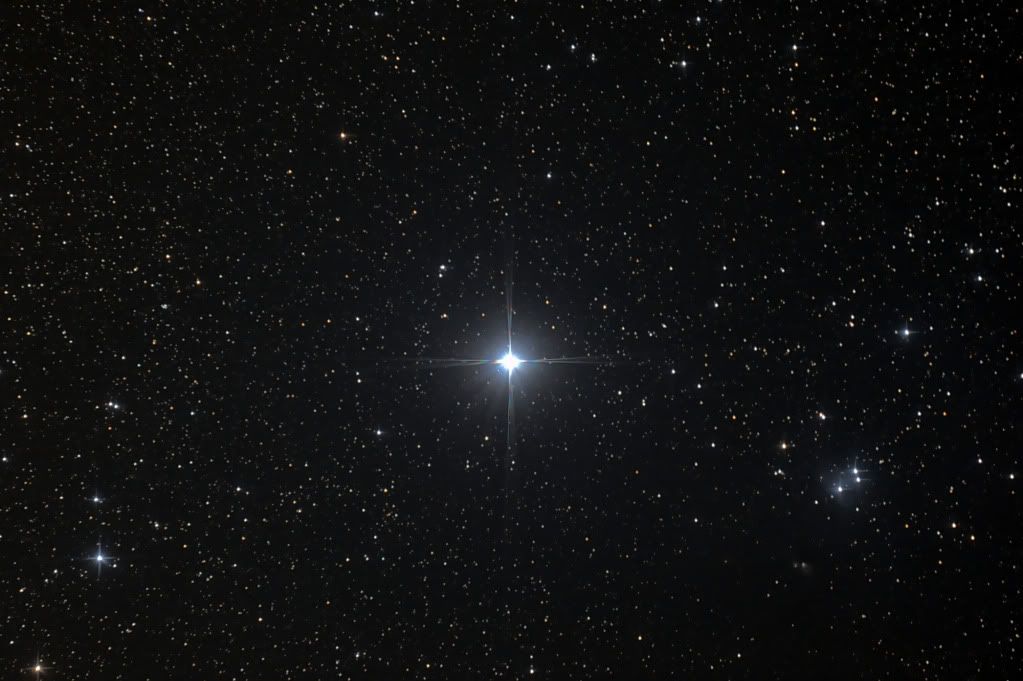Sometimes its nice to just look at stars, lots of them.
December 11, 2012 at 9:20 am
(This post was last modified: December 11, 2012 at 10:22 am by Tiberius.)
But one in particular in this image is interesting.
Caph (Beta Cassiopeiae), in Cassiopeia.
From Wikepedia:
http://en.wikipedia.org/wiki/Beta_Cassiopeiae
Beta Cassiopeiae (β Cas, β Cassiopeiae) is a Delta Scuti variable star in the constellation Cassiopeia. It is a subgiant or giant star belonging to the spectral class F2, with a mean apparent magnitude of +2.27 and absolute magnitude of +1.16. It has the traditional name Caph, from the Arabic word كف kaf, "palm" (i.e. reaching from the Pleiades), also known as Al Sanām al Nākah.[9] Another Arabic name is al-Kaff al-Khadib.[11
β Cassiopeiae is a yellow-white hued subgiant or giant of stellar class F2III-IV, with a surface temperature of 6,700 Kelvin.[12] More than three times the size of and 28 times brighter than the sun, Caph has an absolute magnitude of +1.16. It was once an A-type star with about double the sun's mass.[7] It is now in the process of cooling and expanding to become a red giant. Its core is likely to have used up its hydrogen and is shrinking and heating, while its outer envelope of hydrogen is expanding and cooling. Stars do not spend much time in this state and are relatively uncommon. Caph's corona is unusually weak.[12]
β Cassiopeiae is a variable star of the Delta Scuti type, in fact the second brightest of such stars in the sky after Altair.[14] It is a monoperiodic pulsator,[15] with a brightness that ranges from magnitude +2.25 to +2.31 with a period of 2.5 hours.[12] This type of variables includes subgiant or main sequence stars of spectral classes F5–A0, having masses between 1.5–2.5 solar masses and nearing the end of their core hydrogen fusion lifetime.[15] Their pulsations are related to the same helium instability strip on the Hertzsprung–Russell diagram as that of classical Cepheids. Delta Scuti stars are located at the intersection of the strip with the main sequence.[16]
This star is rotating at about 92% of its critical speed, completing a full rotation every 1.12–1.16 days. This is giving the star an oblate spheroid shape with an equatorial bulge that is 24% larger than the polar radius. This shape is causing the polar region to have a higher temperature than the equator: the temperature difference is about 1,000 K. The axis of rotation is inclined about 20° to the line of sight from the Earth.[7]
β Cassiopeiae is a binary star, with a faint companion, which orbits it every 27 days. Little else is known about this companion.[17]
β Cassiopeiae is approximately 54.7 ± 0.3 ly from our solar system.
Image was taken on 11/12/2012 at the LAS James Baker Observatory, in Curby, Indiana.
'The difference between a Miracle and a Fact is exactly the difference between a mermaid and seal. It could not be expressed better.'
-- Samuel "Mark Twain" Clemens
"I think that in the discussion of natural problems we ought to begin not with the scriptures, but with experiments, demonstrations, and observations".
- Galileo Galilei (1564-1642)
"In short, Meyer has shown that his first disastrous book was not a fluke: he is capable of going into any field in which he has no training or research experience and botching it just as badly as he did molecular biology. As I've written before, if you are a complete amateur and don't understand a subject, don't demonstrate the Dunning-Kruger effect by writing a book about it and proving your ignorance to everyone else! "
- Dr. Donald Prothero
-- Samuel "Mark Twain" Clemens
"I think that in the discussion of natural problems we ought to begin not with the scriptures, but with experiments, demonstrations, and observations".
- Galileo Galilei (1564-1642)
"In short, Meyer has shown that his first disastrous book was not a fluke: he is capable of going into any field in which he has no training or research experience and botching it just as badly as he did molecular biology. As I've written before, if you are a complete amateur and don't understand a subject, don't demonstrate the Dunning-Kruger effect by writing a book about it and proving your ignorance to everyone else! "
- Dr. Donald Prothero








